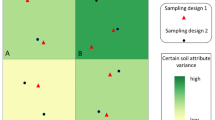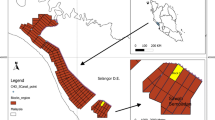Abstract
Sampling design plays a critical role in farm-level digital soil mapping (DSM). In many cases, a soil mapping model may not have been decided upon at the sample design stage. Design-based sampling may be more appropriate than model-based sampling because it is independent of subsequent soil mapping models. However, existing sampling methods optimize the sample size and locations in geographical space or feature space without considering the impacts of environmental similarity in local geographical space. In this paper, a novel sampling design method based on local environmental similarity was developed. Image segmentation was introduced into the sampling design by partitioning agricultural soil into subregions with good spatial continuity, within-region homogeneity, and between-region heterogeneity to determine the optimal sample size and locations. First, the environmental similarity between adjacent soils was calculated. Second, the merging process was iteratively conducted, and a series of segmentations was generated. Finally, the optimal sample size and locations were determined based on the optimal segmentation results. To validate the proposed method, it was compared with stratified random sampling, k-means sampling, and spatially balanced sampling methods. Two mapping models, ordinary kriging and sandwich estimation, were employed to map five soil properties, including pH, soil organic matter, total nitrogen, available phosphorus, and available potassium. These comparative experiments showed that the proposed method had better potential to generate farm-level muti-soil property mapping results with good accuracy than the competing sampling methods. In conclusion, consideration of local environmental similarity and the use of image segmentation for soil sampling were helpful in determining the optimal sample size and key sample locations.










Similar content being viewed by others
Date availability
All data generated or analyzed during this research are included in this article.
References
An, Y. M., Yang, L., Zhu, A. X., Qin, C. Z., & Shi, J. J. (2018). Identification of representative samples from existing samples for digital soil mapping. Geoderma, 311, 109–119. https://doi.org/10.1016/j.geoderma.2017.03.014.
Biswas, A., & Zhang, Y. K. (2018). Sampling designs for validating Digital Soil Maps: A review. Pedosphere, 28(1), 1–15. https://doi.org/10.1016/S1002-0160(18)60001-3.
Blaschke, T. (2010). Object based image analysis for remote sensing. ISPRS Journal of Photogrammetry and Remote Sensing, 65(1), 2–16. https://doi.org/10.1016/j.isprsjprs.2009.06.004.
Brus, D. J. (2015). Balanced sampling: A versatile sampling approach for statistical soil surveys. Geoderma, 253, 111–121. https://doi.org/10.1016/j.geoderma.2015.04.009.
Brus, D. J. (2019). Sampling for digital soil mapping: A tutorial supported by R scripts. Geoderma, 338, 464–480. https://doi.org/10.1016/j.geoderma.2018.07.036.
Brus, D. J., & Heuvelink, G. B. M. (2007). Optimization of sample patterns for universal kriging of environmental variables. Geoderma, 138(1–2), 86–95. https://doi.org/10.1016/j.geoderma.2006.10.016.
Brus, D. J., & Saby, N. P. A. (2016). Approximating the variance of estimated means for systematic random sampling, illustrated with data of the french soil Monitoring Network. Geoderma, 279, 77–86. https://doi.org/10.1016/j.geoderma.2016.05.016.
Canny, J. (1986). A Computational Approach to Edge-Detection. IEEE Transactions on Pattern Analysis and Machine Intelligence, 8(6), 679–698. https://doi.org/10.1109/Tpami.1986.4767851.
Carre, F., McBratney, A. B., Mayr, T., & Montanarella, L. (2007). Digital soil assessments: Beyond DSM. Geoderma, 142(1–2), 69–79. https://doi.org/10.1016/j.geoderma.2007.08.015.
Chen, Y. G. (2021). An analytical process of spatial autocorrelation functions based on Moran’s index. Plos One, 16(4), https://doi.org/10.1371/journal.pone.0249589.
Dobermann, A., & Ping, J. L. (2003). Creating spatially contiguous yield classes for site-specific management. Agronomy Journal, 95(5), 1121–1131. https://doi.org/10.2134/agronj2003.1121.
Dragut, L., & Dornik, A. (2016). Land-surface segmentation as a method to create strata for spatial sampling and its potential for digital soil mapping. International Journal of Geographical Information Science, 30(7–8), 1–18. https://doi.org/10.1080/13658816.2015.1131828.
Espindola, G. M., Camara, G., Reis, I. A., Bins, L. S., & Monteiro, A. M. (2006). Parameter selection for region-growing image segmentation algorithms using spatial autocorrelation. International Journal of Remote Sensing, 27(14), 3035–3040. https://doi.org/10.1080/01431160600617194.
Frogbrook, Z. L., & Oliver, M. A. (2007). Identifying management zones in agricultural fields using spatially constrained classification of soil and ancillary data. Soil Use and Management, 23(1), 40–51. https://doi.org/10.1111/j.1475-2743.2006.00065.x.
Gok, G., & Gurbuz, O. A. (2020). Application of geostatistics for grid and random sampling schemes for a grassland in Nigde, Turkey. Environmental Monitoring and Assessment, 192(5), https://doi.org/10.1007/s10661-020-08281-7.
Hengl, T., Rossiter, D. G., & Stein, A. (2003). Soil sampling strategies for spatial prediction by correlation with auxiliary maps. Australian Journal of Soil Research, 41(8), 1403–1422. https://doi.org/10.1071/Sr03005.
Johnson, B. A., Bragais, M., Endo, I., Magcale-Macandog, D. B., & Macandog, P. B. M. (2015). Image segmentation parameter optimization considering within- and between-segment heterogeneity at multiple scale levels: Test case for Mapping residential areas using Landsat Imagery. ISPRS International Journal of Geo-Information, 4(4), 2292–2305. https://doi.org/10.3390/ijgi4042292.
Lesch, S. M. (2005). Sensor-directed response surface sampling designs for characterizing spatial variation in soil properties. Computers and Electronics in Agriculture, 46(1–3), 153–179. https://doi.org/10.1016/j.compag.2004.11.004.
Loh, W. L. (1996). On latin hypercube sampling. Annals of Statistics, 24(5), 2058–2080. https://doi.org/10.1214/aos/1069362310.
Ma, T. W., Brus, D. J., Zhu, A. X., Zhang, L., & Scholten, T. (2020). Comparison of conditioned latin hypercube and feature space coverage sampling for predicting soil classes using simulation from soil maps. Geoderma, 370, https://doi.org/10.1016/j.geoderma.2020.114366.
McBratney, A. B., Santos, M. L. M., & Minasny, B. (2003). On digital soil mapping. Geoderma, 117(1–2), 3–52. https://doi.org/10.1016/S0016-7061(03)00223-4.
McGarvey, R., Burch, P., & Matthews, J. M. (2016). Precision of systematic and random sampling in clustered populations: Habitat patches and aggregating organisms. Ecological Applications, 26(1), 233–248. https://doi.org/10.1890/14-1973.
Mikelbank, B. A. (2001). Quantitative geography: Perspectives on spatial data analysis. Geographical Analysis, 33(4), 370–372. https://doi.org/10.1111/j.1538-4632.2001.tb00453.x.
Minasny, B., & McBratney, A. B. (2006). A conditioned latin hypercube method for sampling in the presence of ancillary information. Computers & Geosciences, 32(9), 1378–1388. https://doi.org/10.1016/j.cageo.2005.12.009.
Minasny, B., & McBratney, A. B. (2016). Digital soil mapping: A brief history and some lessons. Geoderma, 264, 301–311. https://doi.org/10.1016/j.geoderma.2015.07.017.
Odeh, I. O. A., McBratney, A. B., & Chittleborough, D. J. (1990). Design of optimal sample spacings for mapping soil using fuzzy-k-means and regionalized variable theory. Geoderma, 47(1), 93–122. https://doi.org/10.1016/0016-7061(90)90049-F.
Oliver, M. A., & Webster, R. (1990). Kriging: A method of interpolation for geographical information systems. International Journal of Geographical Information Systems, 4(3), 313–332. https://doi.org/10.1080/02693799008941549.
Pedroso, M., Taylor, J., Tisseyre, B., Charnomordic, B., & Guillaume, S. (2010). A segmentation algorithm for the delineation of agricultural management zones. Computers and Electronics in Agriculture, 70(1), 199–208. https://doi.org/10.1016/j.compag.2009.10.007.
Pekkarinen, A. (2002). A method for the segmentation of very high spatial resolution images of forested landscapes. International Journal of Remote Sensing, 23(14), 2817–2836. https://doi.org/10.1080/01431160110076162.
Pusch, M., Samuel-Rosa, A., Oliveira, A. L. G., Magalhães, P. S. G., & do Amaral, L. R. (2022). Improving soil property maps for precision agriculture in the presence of outliers using covariates. Precision Agriculture. https://doi.org/10.1007/s11119-022-09898-z.
Strand, G. H. (2017). A study of variance estimation methods for systematic spatial sampling. Spatial Statistics, 21, 226–240. https://doi.org/10.1016/j.spasta.2017.06.008.
Su, T. F. (2017). A novel region-merging approach guided by priority for high resolution image segmentation. Remote Sensing Letters, 8(8), 771–780. https://doi.org/10.1080/2150704x.2017.1320441.
Su, T. F. (2019). Scale-variable region-merging for high resolution remote sensing image segmentation. ISPRS Journal of Photogrammetry and Remote Sensing, 147, 319–334. https://doi.org/10.1016/j.isprsjprs.2018.12.003.
Tremeau, A., & Colantoni, P. (2000). Regions adjacency graph applied to color image segmentation. IEEE Transactions on Image Processing, 9(4), 735–744. https://doi.org/10.1109/83.841950.
Vasat, R., Boruvka, L., & Jaksik, O. (2012). Number of sampling points influences the parameters of soil properties spatial distribution and kriged maps. Digital Soil Assessments and Beyond, 251–256.
Walvoort, D. J. J., Brus, D. J., & de Gruijter, J. J. (2010). An R package for spatial coverage sampling and random sampling from compact geographical strata by k-means. Computers & Geosciences, 36(10), 1261–1267. https://doi.org/10.1016/j.cageo.2010.04.005.
Wang, J. F., Stein, A., Gao, B. B., & Ge, Y. (2012). A review of spatial sampling. Spatial Statistics, 2, 1–14. https://doi.org/10.1016/j.spasta.2012.08.001.
Wang, J. F., Haining, R., Liu, T. J., Li, L. F., & Jiang, C. S. (2013a). Sandwich estimation for multi-unit reporting on a stratified heterogeneous surface. Environment and Planning a-Economy and Space, 45(10), 2515–2534. 10.1068/a44710.
Wang, J. F., Jiang, C. S., Hu, M. G., Cao, Z. D., Guo, Y. S., Li, L. F., & Meng, B. (2013b). Design-based spatial sampling: Theory and implementation. Environmental Modelling & Software, 40, 280–288. 10.1016/j.envsoft.2012.09.015.
Wang, J. H., Ge, Y., Heuvelink, G. B. M., & Zhou, C. H. (2014). Spatial Sampling Design for estimating Regional GPP with spatial heterogeneities. IEEE Geoscience and Remote Sensing Letters, 11(2), 539–543. https://doi.org/10.1109/Lgrs.2013.2274453.
Wang, Y. J., Meng, Q. Y., Qi, Q. W., Yang, J., & Liu, Y. (2018). Region merging considering within- and between-segment heterogeneity: An Improved Hybrid Remote-Sensing Image Segmentation Method. Remote Sensing, 10(5), https://doi.org/10.3390/rs10050781.
Wang, Y. J., Jiang, L. L., Qi, Q. W., Liu, Y., & Wang, J. (2019). Remote sensing-guided Sampling Design with both good spatial Coverage and Feature Space Coverage for Accurate Farm Field-Level Soil Mapping. Remote Sensing, 11(16), https://doi.org/10.3390/rs11161946.
Wang, Y., Qi, Q., Bao, Z., Wu, L., Geng, Q., & Wang, J. (2022a). A novel sampling design considering the local heterogeneity of soil for farm field-level mapping with multiple soil properties. Precision Agriculture. 10.1007/s11119-022-09926-y.
Wang, Y. J., Wu, L. L., Qi, Q. W., & Wang, J. (2022b). Local scale-guided hierarchical region merging and further over- and Under-Segmentation Processing for Hybrid Remote sensing image segmentation. Ieee Access: Practical Innovations, Open Solutions, 10, 81492–81505. 10.1109/Access.2022b.3194047.
Yang, L., Zhu, A. X., Qi, F., Qin, C. Z., Li, B. L., & Pei, T. (2013). An integrative hierarchical stepwise sampling strategy for spatial sampling and its application in digital soil mapping. International Journal of Geographical Information Science, 27(1), 1–23. https://doi.org/10.1080/13658816.2012.658053.
Yang, J., He, Y. H., & Caspersen, J. (2017). Region merging using local spectral angle thresholds: A more accurate method for hybrid segmentation of remote sensing images. Remote Sensing of Environment, 190, 137–148. https://doi.org/10.1016/j.rse.2016.12.011.
Yang, L., Li, X. M., Shi, J. J., Shen, F. X., Qi, F., Gao, B. B., & Zhou, C. H. (2020). Evaluation of conditioned latin hypercube sampling for soil mapping based on a machine learning method. Geoderma, 369, https://doi.org/10.1016/j.geoderma.2020.114337.
Zhu, A., Yang, L., Fan, N., Zeng, C., & Zhang, G. (2018). The review and outlook of digital soil mapping. Progress in Geography, 37(1), 66–78. https://doi.org/10.18306/dlkxjz.2018.01.008.
Acknowledgements
This work was supported by the Joint Project of Science and Technology Research and Development Plan in Henan Province (project number: 222103810012), Key Scientific Research Projects of Colleges and Universities in Henan Province (project number: 22A170021), and Science and Technology Research and Development Projects in Henan Province (project number: 232102111100). The authors would like to thank the reviewers and editors for valuable advice and comments.
Author information
Authors and Affiliations
Corresponding author
Ethics declarations
Conflict of interest
The authors declare that they have no conflicts of interest.
Additional information
Publisher’s Note
Springer Nature remains neutral with regard to jurisdictional claims in published maps and institutional affiliations.
Rights and permissions
Springer Nature or its licensor (e.g. a society or other partner) holds exclusive rights to this article under a publishing agreement with the author(s) or other rightsholder(s); author self-archiving of the accepted manuscript version of this article is solely governed by the terms of such publishing agreement and applicable law.
About this article
Cite this article
Wang, Y., Qi, Q., Wang, J. et al. The potential of image segmentation applied to sampling design for improving farm-level multi-soil property mapping accuracy. Precision Agric 24, 2350–2373 (2023). https://doi.org/10.1007/s11119-023-10043-7
Accepted:
Published:
Issue Date:
DOI: https://doi.org/10.1007/s11119-023-10043-7




